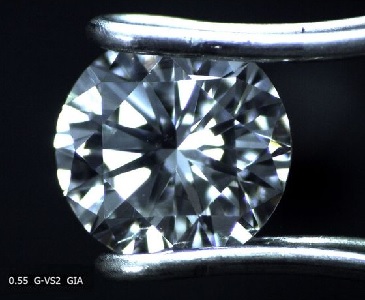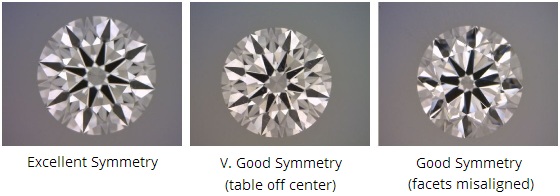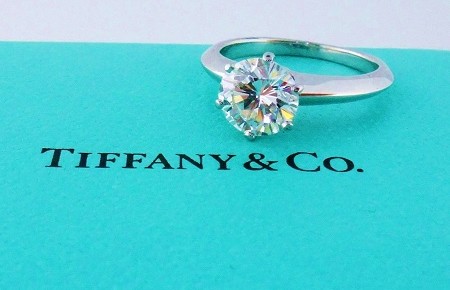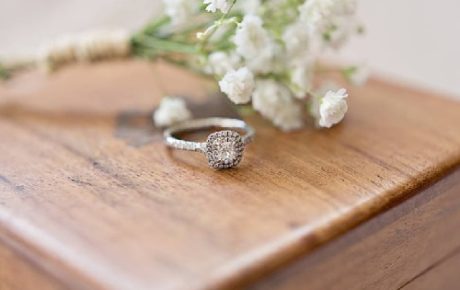Diamond Polish And Symmetry Grading – The Ultimate Guide

Anatomy of a polished diamond (facet nomenclature).
Polish and symmetry are two important characteristics that are documented in a grading report. Collectively, they account for a diamond’s finish and craftsmanship.
Polish refers to the overall smoothness and condition of the diamond’s surface. A well polished diamond can produce crisp reflections and undistorted light transmission while a poorly polished diamond can look dull.
Symmetry, on the other hand, refers to the exactness of shape, overall outline, placement and alignment of individual facets. A diamond with poor symmetry will have a visible deviation from its shape and reduced brilliance due to misdirected light transmission.
Before we delve into the nitty gritty technical explanations, here are my minimum recommendations of polish and symmetry ratings when you are selecting diamonds.
| Super Ideal Hearts And Arrows | Round Diamond | Fancy Shapes | |
|---|---|---|---|
| Polish | Excellent/Ideal | Excellent | Very Good |
| Symmetry | Excellent/Ideal | Excellent | Very Good* |
* Shape appeal must be judged in person or via a magnified video/photograph.
While refining their grading system, GIA conducted an observational study based on 70,000 diamonds many years back. It was discovered that diamonds with a symmetry grade of ‘Good’ were generally less preferred by both consumers and trade participants. Interestingly, it didn’t matter that these diamonds were cut to “ideal” proportions which qualified them for excellent cut ratings.
For that reason, GIA only allows the overall cut grade to be one rating higher than the diamond’s symmetry or polish rating. For example, a diamond with “very good” symmetry could still receive an overall cut grade of “excellent cut” if its other parameters are within the limits of the excellent grade. However, another diamond with “good” symmetry would only receive a “very good” cut grade at best even if all the parameters meet “excellent” standards.
Excellent Ratings Doesn't Equate to Perfection
Did you know that an excellent rating for symmetry and polish doesn’t mean that the diamond is 100% perfect? In reality, diamonds with very faint polish lines or minor symmetry flaws can still be assigned an Excellent rating as long as it is within tolerances.
Common Polish Features Found on a Diamond
Almost every diamond (except for flawless stones) has some remnants of polishing marks on its surface. In the case of a diamond with an “excellent” polish rating, the polish lines are so fine that they can only be seen under high magnification and via a specific tilt angle.
When gemological labs evaluate a diamond for its polish rating, they examine the facets for surface blemishes such as:
Scratch – Transparent looking white line on the diamond’s surface.
Nick – Minute notches found on facet or girdle junctions.
Abrasion – Caused by a series of nicks at facet junctions.
Pit – A small opening usually cause by pinpoint inclusions falling out of their pockets during polishing.
Lizard skin – Bumpy looking texture on a diamond’s surface.
Polish lines – Scarcely visible fine lines that can be white or translucent.
Rough girdle – An unpolished girdle left in its original state after bruting.
Burn marks – A layer of whitish haze typically caused by high temperatures from a jeweler’s torch or polishing wheel.
As you can see from the descriptions above, the most important attribute of polish features is that they do not penetrate the diamond’s surface. That is why they are judged as separate entities away from clarity characteristics (inclusions).
OK, What About Diamond Symmetry Flaws? Why Do They Occur?

An inclusion is polished off and resulted in an extra facet – GIA.
There’s a big misconception that the presence of symmetry defects indicate poor cutting skills. That is not true.
In fact, most of the decisions made during the cutting process are carefully planned and “real” mistakes are extremely rare. You see, the main goal a cutter wants to achieve when polishing a rough diamond is to get the maximum value out of the rough.
Often times, the decision to polish a rough stone prioritizes carat weight retention and compromises cut quality. Cutters may purposely create facets that don’t meet accurately in order to attain ‘magic weights’ like 1.00 carat or to eliminate inclusions from the end product.
The rationale behind doing this is that a diamond with “good” symmetry (at 1 carat weight) is more marketable and valuable compared to a diamond with “excellent” symmetry (at 0.96 carat weight). It’s sad that cut quality is usually the first aspect to get sacrificed but this is how economics work in real life.
Sometimes, an extra facet or a misshapen facet is purposely introduced to remove an inclusion and to improve the diamond’s clarity grade. This is a calculated move as the symmetry flaw doesn’t impact value as much as the improvement in clarity grade does.
Symmetry Grading – Using a Round Brilliant Cut As An Example
The grading methodology for symmetry can be further sub-divided into 2 types of categories – proportions and facets related.
A symmetry alteration that affects the alignment and balance of a diamond’s facet structure is considered a proportioning flaw. These flaws are usually measurable and affect the diamond’s overall appearance. These include the following:

Out of round girdle outline – The diamond doesn’t appear round and may have squared-off areas.
Off-center table – The table facet does not appear centralized on the crown view.
Off-center culet – From the face up view, the point where pavilion mains meet is not centralized correctly.
Table/culet alignment – Table and culet are wrongly positioned.
Pavilion angle variation – Significant variation of the 8 measured pavilion angles.
Crown angle variation – Significant variation of the 8 measured crown angles.
Wavy girdle – Instead of having consistency, the girdle takes on a wave-like appearance.
Girdle thickness variation – Variations in girdle thickness around the diamond’s rim.

G color VS2 clarity With G/G finish ratings
On the other hand, facet related flaws are focused on the regularity of individual facets. Basically, similar facets should all be cut to equal sizes and regularity (i.e. all bezel facets should look the same, all pavilion main facets should look the same and etc…).
Missing/Extra facets – Usually placed or removed without regards to symmetry to remove inclusions.
Misshapen facets – Unequal shape and size of facets.
Truncated facets – The points of the facets do not terminate correctly at the girdle.
Table not a regular octagon – Unequal 8 sided table facet.
Non-pointing – Facets fail to meet into a single point at junctions.
Misalignment of crown and pavilion facets – Wrong placements of bezel and pavilion mains. Severe displacements usually lead to the formation of a wavy girdle.
What Do The Individual Grades Represent?
In the gemological labs, symmetry and polish are graded based on a 10X magnification. A microscope is first used to detect symmetry issues and this is followed by an overall observational analysis with the naked eye.
Summarized Criteria of Polish Grading by GIA
Excellent – No or very insignificant features that are difficult to see with 10X magnification
Very Good – Polish features can be seen face up with a 10X magnification
Good – Noticeable features can be seen under 10X magnification. Luster may be impacted.
Fair – Obvious features can be seen under 10X. Luster of diamond is affected.
Poor – Distinct features that can be seen even without magnification. Luster is severely affected.
Summarized Criteria of Symmetry Grading by GIA

Excellent – Absence or minute flaws that are hard to find under 10X.
Very Good – Minor symmetry flaws that can be detected in the face up view under 10X.
Good – Noticeable features can be seen under 10X magnification. Visual appearance may be affected.
Fair – Obvious symmetry problems can be seen under 10X. Visual appearance is affected.
Poor – Prominent issues that can be seen even without magnification. Visual appearance is severely affected.
Here’s My Honest Opinion About Symmetry & Polishing Grades
Unlike cut proportions like table % and depth %, symmetry/polish grades have lesser impact on the diamond’s visual appearance. In fact, the differences between a “very good” and “excellent” symmetry grade are not readily seen by the naked eyes.
If you are only given a choice between having better polish/symmetry or better cut proportions, I would recommend going for the latter option (especially if you are choosing fancy cuts).
Speaking from personal experience, I know it is easy to become overly zealous about a diamond’s polish/symmetry. I had also received many emails from readers who get too caught up with grade obsession and that’s something I want to address.
On the next page, I want to go in-depth about how symmetry can impact cut quality and highlight when it might become a cause of concern for you.
Related Articles
Leave A Comment














10 Comments
How important is symmetry in a diamond and what are the gia symmetry limits? If we compare a stone with fair and good ratings, how big of a different is it in real life? Also, I want to know whether a perfect diamond symmetry is required for it to look beautiful.
If we go down to the lower levels of symmetry ratings like “good” and “fair”, you will be able to see distortions with the naked eye. Basically, the overall shape will be affected and can easily be observed.
For perfect symmetry, I find that it is generally more important in round brilliant cuts. It’s easily achievable as well with modern cutting technology and tools. For fancy shapes, symmetry may not be that large of an issue. Ratings with “very good” and “excellent” tend to be my minimum requirements when I choose stones. There’s no hard and fast rules when fancies are involved.
I have another question. Along the same line as the one I asked earlier, how does polish affect diamond appearances in real life? The ratings listed in the GIA diamond polish charts seem to have negligible concerns between a very good and excellent grade.
The differences are almost impossible to see with the naked eye. I personally think polish is an even more subtle attribute than symmetry.
Hi! I’m torn between 2 diamonds & I’m hoping you could give me some advice. The first diamond has an H color, VVS2 clarity, and very good symmetry and polish. The 2nd diamond has an I color, VS1 clarity, and excellent symmetry and polish. All other things equal, do you think there’s an obvious choice between the two? if so, which one would that be? Thanks in advance for your help!
Read this: https://beyond4cs.com/buying-diamonds-blind/
I was looking at two heart cut diamonds from James Allen and want to know how important is symmetry in a diamond. What are the differences between very good vs excellent as I cannot seem to see any changes in the shape or outline of the diamonds.
Would love to hear back from you ASAP.
For fancy shape diamonds, the differences between very good and excellent symmetry are largely technical instead of visual. I would pay attention to the videos and see how they look like in real life rather than relying on the grading report.
I say this because I’ve seen plenty of VG/VG symmetry and polish diamonds look and have better sparkle than diamonds with Ex/Ex ratings. My limit for GIA symmetry grades is actually a “Good” rating. And I won’t even consider any diamonds with a poor symmetry grade.
Hello, I’m hoping to get your opinion on a fancy deep bluish/green colored diamond. If the diamond is rated with: good cut, good polish, good symmetry, and transparent clarity – how would this grading affect a colored stone? I know these grading would not be ideal for a colorless stone, but what about a colored enhanced stone? And speaking of colored enhanced, does color enhancement affect the integrity of the stone? Looking forward to your feedback. Thank you.
The fact that you are using “good cut” and “transparent clarity” terms doesn’t bode well. Who graded the diamond? GIA or some unknown scumbag gemological lab? I know for sure GIA doesn’t use them in this manner. With colored diamonds, the emphasis is on color and the good ratings on polish/symmetry could affect its outline and luster.
Color enhancement treatment has nothing to do with the integrity (durability) of the diamond. What I will say is this. When jewelers send diamonds for enhancement, they are usually bottom tier and garbage quality in terms of color and clarity. If there are issues with durability, it stems from the inherent clarity problems the stone already has and isn’t caused by the treatment. It sure looks like you are going to get ripped off by whichever scumbag jeweler you are dealing with who is selling this diamond.